Cryptocurrency Information
Bitstamp: Cryptocurrency Exchange User’s Guide To Buy, Sell & Trade
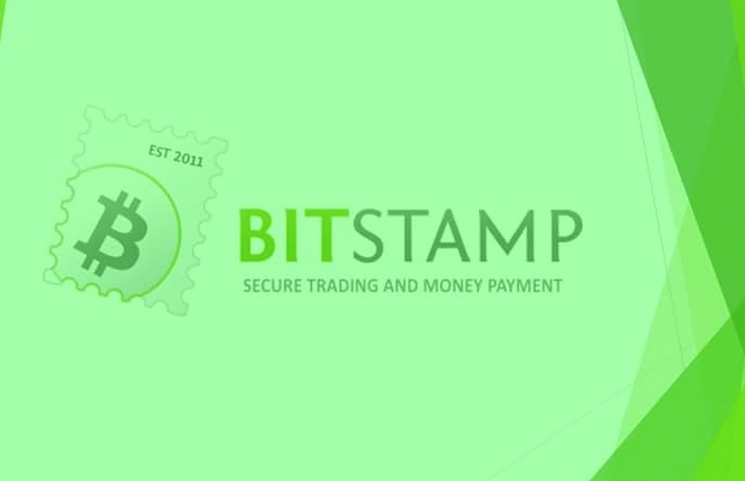
A well-respected exchange that gets credited with being one of the most reliable exchanges with some of the lowest transaction fees. Best suited for intermediate to advanced users investing with larger amounts of capital, and maybe a bit too complex for beginners. An exchange that accepts limited payment methods, and pretty high deposit fees on small amounts of money.
Table Of Contents
In this write-up, we’ll be reviewing the Bitstamp exchange, as well as guiding you through the most common practices on the exchange.
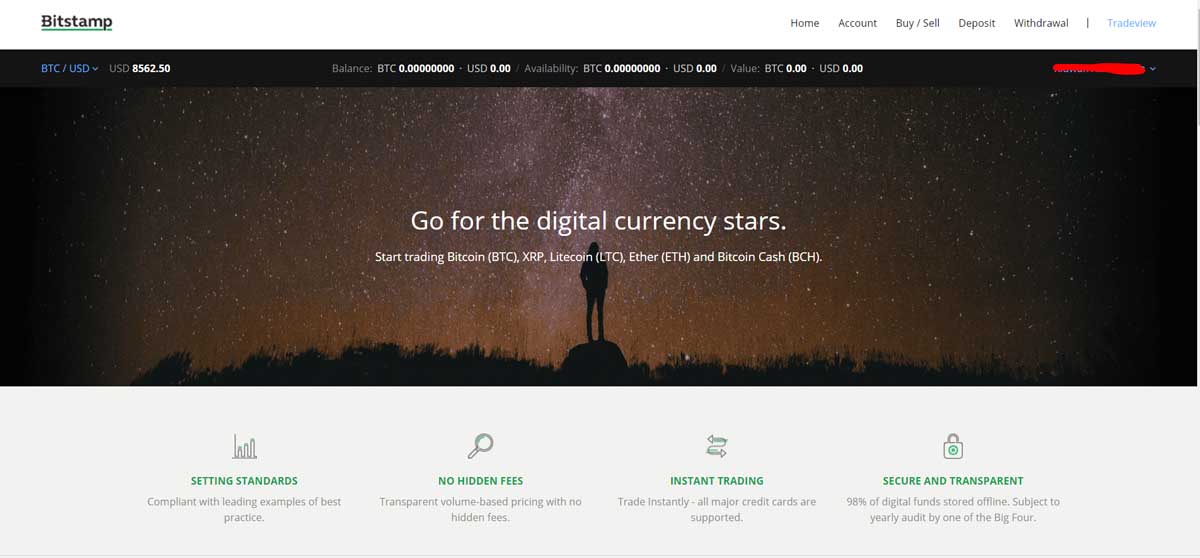
What is Bitstamp?
Bitstamp is one of the oldest and largest Bitcoin exchanges in the world. It is one of the top ten exchanges by volume online. Bitstamp is also one of the four exchanges that determine the CoinDesk Bitcoin Price Index. Thus, Bitstamp exerts an extremely powerful influence on the cryptocurrency market as a whole. Over the years, the exchange has experienced a lot of challenges in the cryptocurrency world and has been able to adjust and adapted necessarily to maintain her stand.
Bitstamp was founded as a result of a partnership between Damijan Merlak and Nejc Kodric as a competitor to the then-dominant Mt. Gox exchange in 2011. The exchange was formerly based in Slovenia and was later relocated to Luxembourg as a result of lack of the financial infrastructure in the country. Being a European-based exchange, Bitstamp enjoys popularity among many Europeans cryptocurrency traders as it is very convenient for European users to deposit Euros.
Bitstamp has maintained a proactive approach to adhering to KYC and AML practices since inception, and thus was the first exchange to be granted a national payment institution license by Luxembourg in 2016, making it the first officially-licensed cryptocurrency exchange in history.
Bitstamp allows trading between USD and EUR for a variety of cryptocurrencies including Bitcoin, Litecoin, Ethereum, and Ripple.
Additionally, Bitstamp offers its API to allow users to create custom software to access and use their accounts.
Features Of The Bitstamp Exchange
Security
Bitstamp is known to be one of the most secure exchanges in the world. However, it is to be noted that Bitstamp has experienced a lot of security challenges including:
- A DDOS attack by hackers in 2014, when hackers demanded a ransom of 74 BTC. The exchange suspended withdrawals as a security measure, refusing the ransom, and the exchange service was restored.
- Suspension of service experienced in January 2015. Bitstamp chose to suspend its service for about a week after it was hacked for 19,000 bitcoins. The hackers were reported to have used Skype and email communications with employees to introduce malware into the exchange’s system, and the malware retrieved the private keys of the company’s hot wallets.
These two threats have made Bitstamp better and stronger in terms of security, with each security threat paving ways for much more innovative and reliable security measures.
The following security measures were employed by the exchange in securing her customers’ fund:
Cold wallet Storage:
Bitstamp keeps around 98% of all of its coins in cold wallets and keeps its customers’ funds offline in secure vaults. The rest is kept for live trading via the exchange. Bitstamp sets the standard for best security practices with its fully secured cold-storage.
Two-Factor Authentication (2FA):
The 2FA is an extra layer of security that requires not only a password and username but also something that only the user has on them. Users can add an extra layer of security to their accounts using the common authenticator applications present on the Appstore/ Playstore.
Confirmation emails:
Bitstamp also offers email alerts. This method is employed to assure the user is actually the one making requests from the webApp and not bots. An email is sent containing a customer ID and password to your inbox just after filling the registration form. Users are required to change the password immediately after receiving the mail at the first time.
Pretty Good Privacy (PGP):
PGP is a standard public key encryption program for email encryption. PGP is used to sign messages so that the receiver can verify both the identity of the sender and the integrity of the content. PGP uses a private key that must be kept secret and a public key that sender and receiver must share. Bitstamp uses PGP data encryption to authenticate all the uploaded files to the web application.
Know Your Customer (KYC):
Every customer must verify the account by providing full name, postal address and date of birth before executing any trade on the platform. To authenticate this information, Bitstamp also requires users to upload a government-issued ID and a no more than three-months-old utility bill to prove place of residence.
However, with all these security measures employed, traders must always note that the best practice is keeping their fund in a private cold wallet.
Low Fees
Bitstamp is known for her lower fee system than the majority of cryptocurrency exchanges. Bitstamp charges for a long list of service and operational fees including declined cash withdrawals, a monthly account fee, and a dormancy fee. A notable feature of Bitstamp is that you don’t have to pay transaction fees when withdrawing BTC. This feature is awesome, especially for traders involving in alt-coins on different exchanges. Bitstamp accomplishes this by aggregating the payment with a bunch of other payments, and then they cover the fee for the trader.
Bitcoin trading fees cost .25% for monthly volumes less than $20, with the percentage dropping with an increase in volume down to .10% for a monthly volume of $20 million. A few of the fees are as follows:
| 0.25% | < $20,000 |
| 0.24% | < $100,000 |
| 0.22% | < $200,000 |
| 0.20% | < $400,000 |
| 0.15% | < $600,000 |
| 0.14% | < $1,000,000 |
| 0.13% | < $2,000,000 |
| 0.12% | < $4,000,000 |
| 0.11% | < $20,000,000 |
| 0.10% | > $20,000,000 |
Click here to see the full breakdown of the trading fees
API Support
An application-programming interface (API) is a set of programming instructions and standards for accessing a Web-based software application or Web tool. A software company releases its API to the public so that other software developers can design products that are powered by its service. Bitstamp’s application programming interface (API) allows clients to access and control their accounts using the customized software. Bitstamp’s API support includes HTTP API, WebSocket API, and FIX. However, Bitstamp does not allow make more than 600 API requests within the range of 10 minute periods. Else, the system will understand the action to be from bots or an action to toward hacking the system.
International Availability
BitStamp is widely used within UK and US. In addition, the exchange is currently available to over 60 countries. including Australia, Brazil, China, Hong Kong, India, Japan, New Zealand, Singapore, and South Korea.
Ease of Use
Bitstamp offers a highly intuitive tradeview feature that, while somewhat complex, offers a rich tool set that provides users with the ability to chart technical indicators such as accumulative swing index, ATR bands, Bollinger bands, and more. More than 11 different tools can be used in the complex technical analysis.
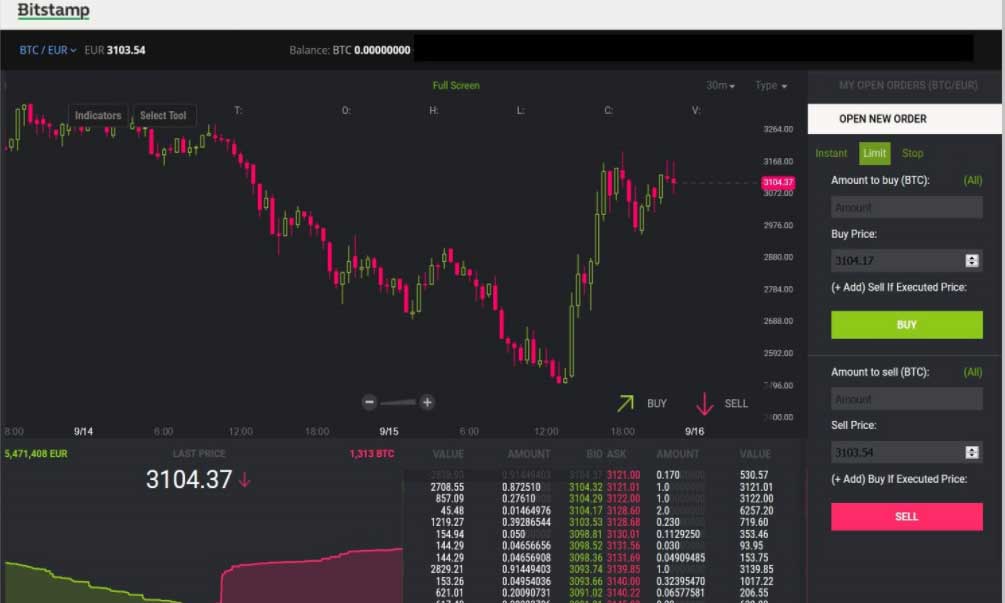
This interface makes observing market trends extremely easy, streamlines order placement, and presents open orders in a simple fashion. Account management is managed via a convenient top menu, which presents Account, Buy / Sell, Deposit, and Withdrawal links, along with a link to the Tradeview.
The funding interface is particularly easy to use on Bitstamp, and presents a clean breakdown of all available payment methods:
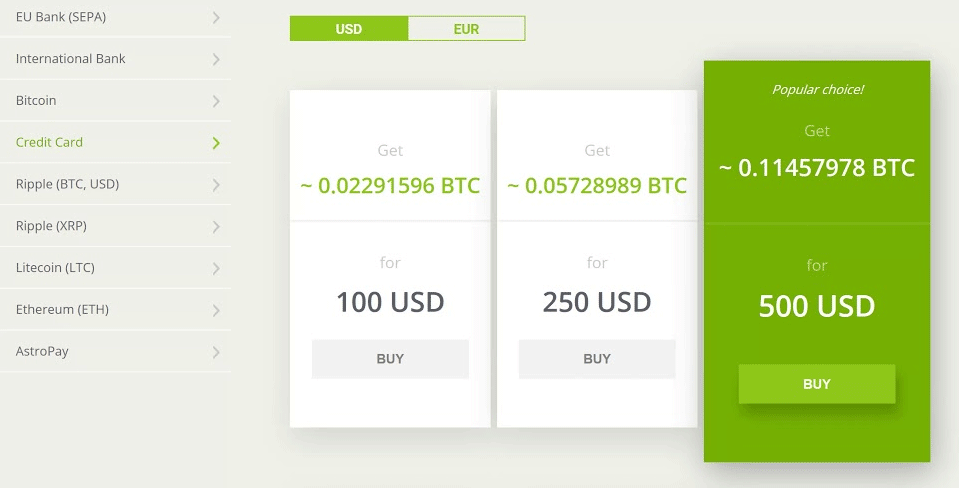
Bitstamp Sign Up & Identification
You can easily open an account by entering your name, email address, country of residence, and password. Visit the Official Bitstamp address and create an account by following the signup process.
Note: Make sure you are on the official website and not a cloned one. Make sure the protocol on your web browser link is HTTPS and not HTTP.
You can also use Cryptonite by MetaCert. Using Cryptonite, you must ensure the shield turns green when you’re on the website. As shown below:
![]()
![]()
1. Create an Account
- Click on either ‘Register’ or Signup button on the homepage as shown below:

- You will be re-directed to the registration page.
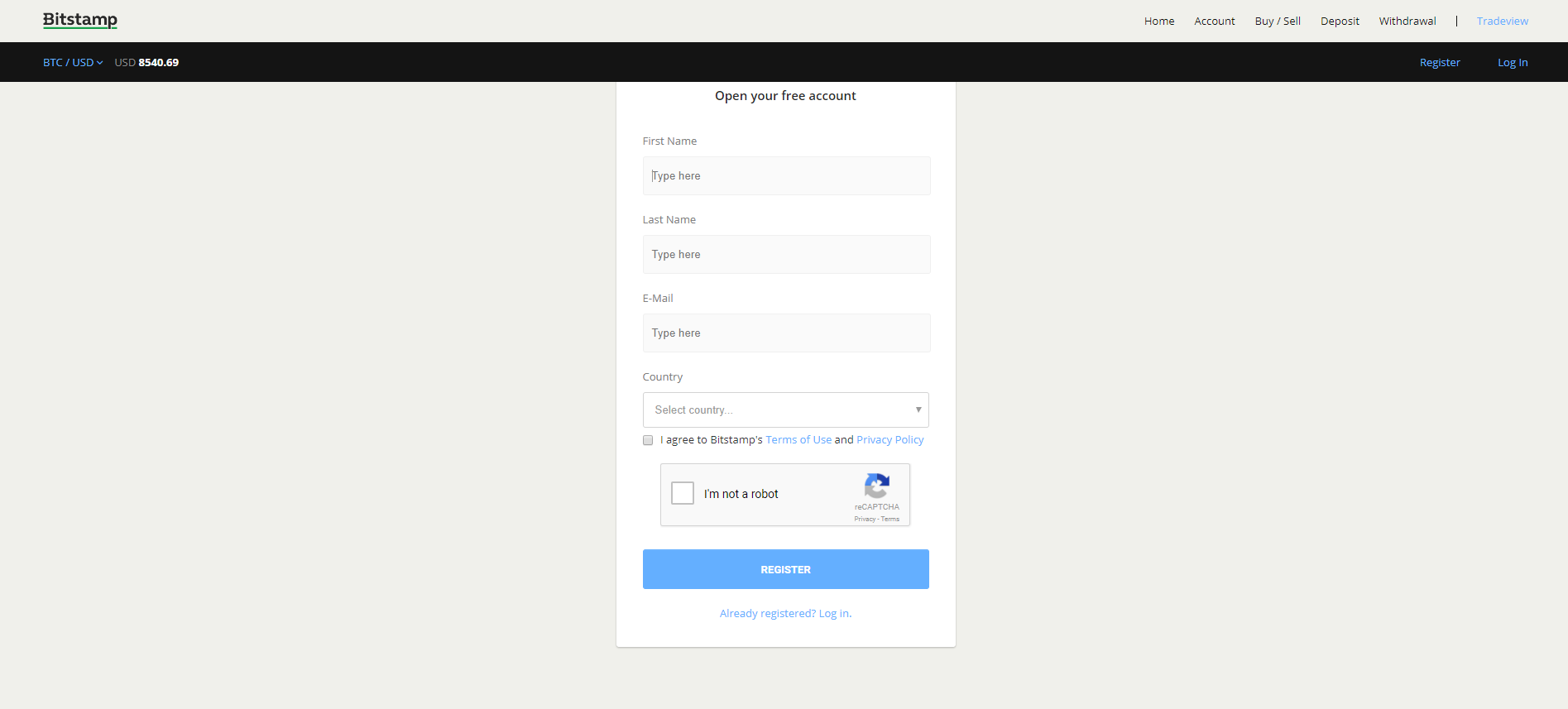
- Input your name, email address, country of residence. and tick the terms and conditions. Then click on the REGISTER
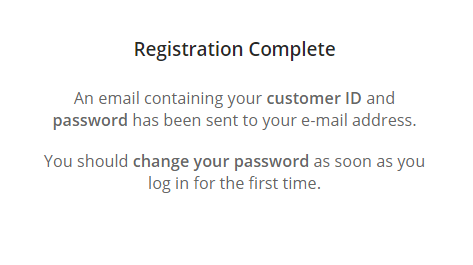
- Wait for the confirmation e-mail to the email address you provided. In the mail, you’ll be provided with automatically generated unique client Id and password. Log in to the website and change your password.
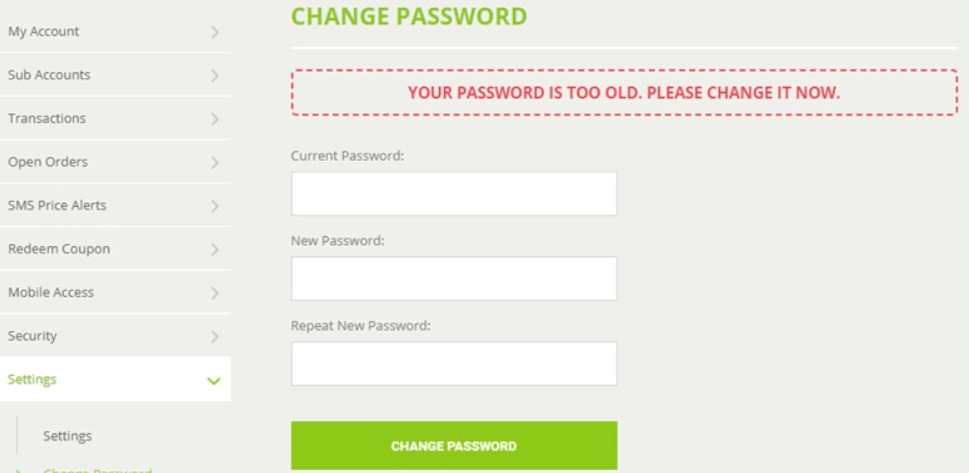
- Set Your 2- factor Authenticator: You can either use the Google Authenticator app or DUO. Follow this guide on how to set-up your 2- factor authentication.
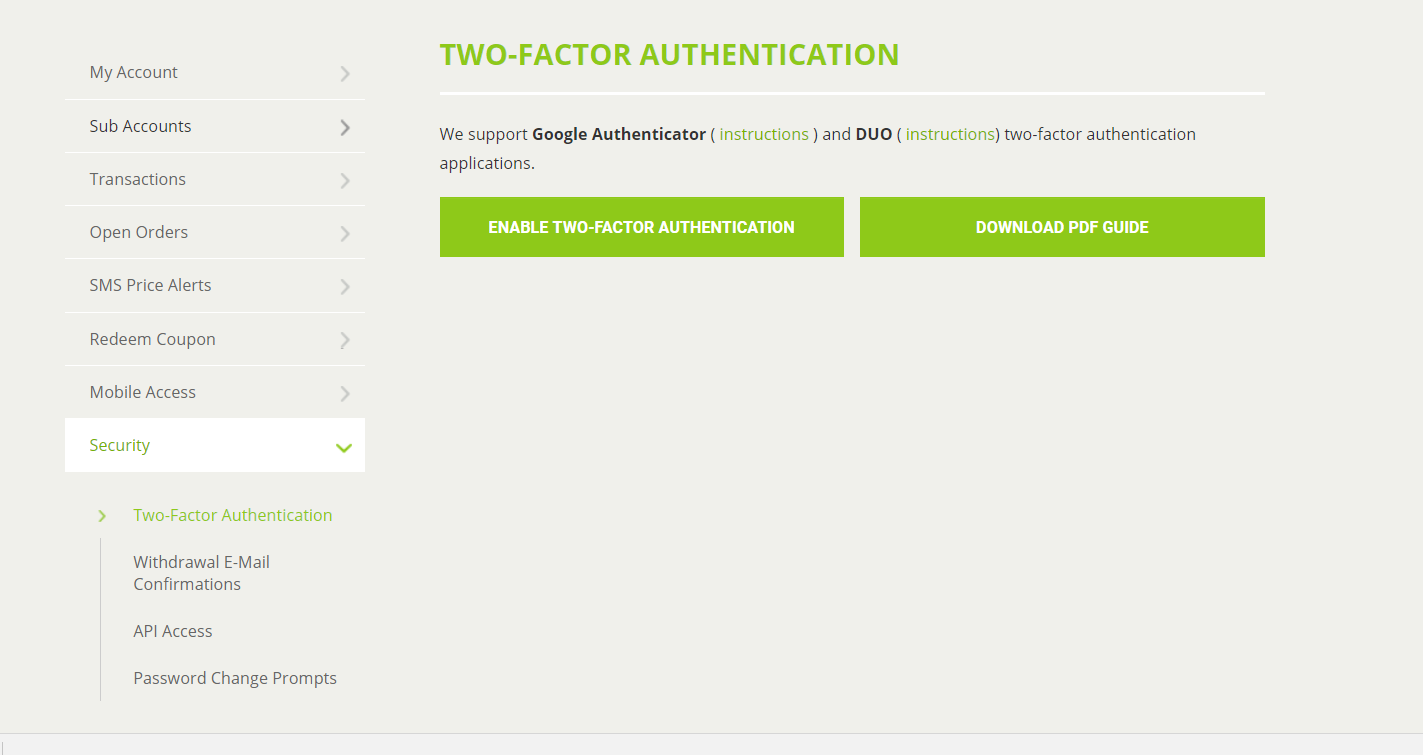
2. Verify your account
Unlike other exchanges, Bitstamp doesn’t allow unverified accounts to trade, which is attributed to the fact that it facilitates direct bank transfers, credit card payments, and integrates with traditional financial institutions. All of these features greatly require KYC process. Therefore, in order to gain access to certain account functions such as bank transfers, it’s necessary to verify your account.
The verification process is in two stages:
1. Identity Verification
Bitstamp provides personal and corporate accounts and both require the following documentation to become verified:
- A valid Citizenship/National ID. Passports and drivers’ licenses can also be used.
- Proof of residence, this includes a bank statement, utility bill, and a variety of government-issued.
Enter your personal details exactly as they appear on your identity documents.
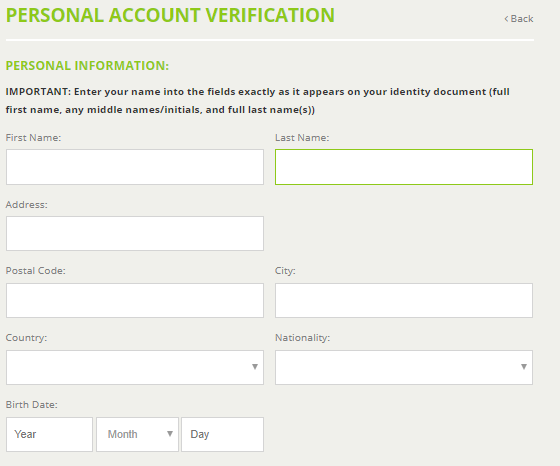
- The next section will require a high-resolution image of your government-issued ID document. Make sure this document is valid, clearly defined, and visible in its entirety. You’ll need to upload both front and back side images, enter the validity dates of the document, the document number, and the document type.
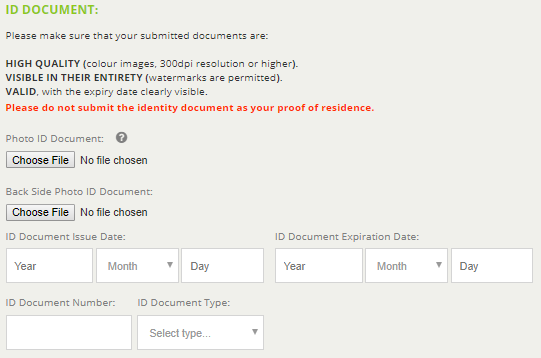
- Lastly, you’ll need to upload your proof of residence documents. Acceptable proof of resident document is as specified above.
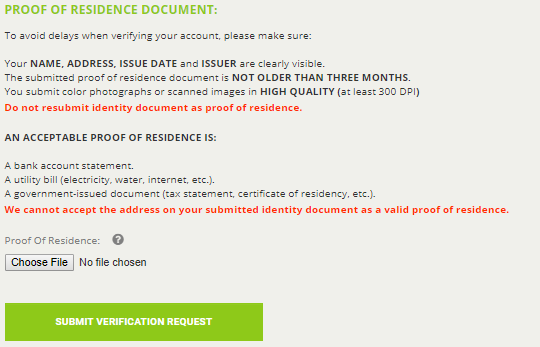
2. SMS Verification
The second verification phase requires users to verify their phone number by using an OTP code that is sent to their phone. This should be done after the identity verification.
3. KYC FORM
The last stage of the verification is to fill the KYC form.
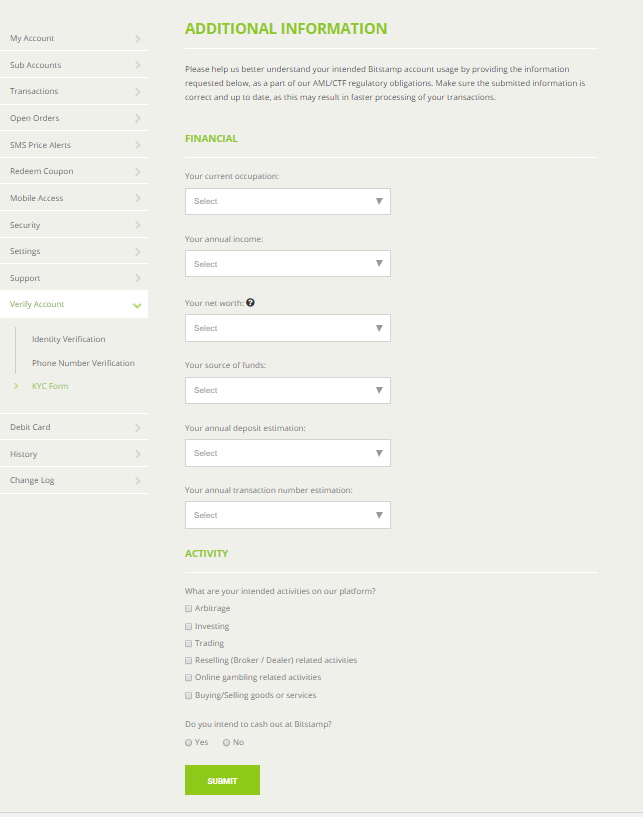
According to Bitstamp, the verification takes up to two business days. Once you are a verified user, there are no limits to your trades.
3. Deposit & Withdrawal Methods
On Bitstamp, it’s possible to fund your account via a diverse range of methods. Verified Bitstamp users are able to fund their accounts with SEPA transfers or direct bank wire transfer in EUR, GBP, CHF, or USD.
Customers within the UK can make withdrawals via SEPA transactions or via international wire transfer for GBP, USD, and CHF. Withdrawals in the SEPA zone take 2-3 business days, while international wire transfers take up to 5 business days.
Bitstamp deposit methods include cryptocurrencies such Ripple, Bitcoin, Ethereum, Bitcoin Cash, and Litecoin. These cryptos can be withdrawn or deposited free of charge from Bitstamp wallets.
4. Funding Your Account
Making SEPA deposits and cryptocurrencies such Ripple, Bitcoin, Ethereum, Bitcoin Cash, and Litecoin incurs no charge. However, Purchasing Bitcoin via credit or debit card on Bitstamp incurs a fee of 5%. Also, International wire transfer funding incurs a 0.05% fee, with a minimum fee of $7.5 USD and a maximum fee of $300 USD.
To fund your account:
In this example, we’ll describe how to deposit EUR.
- In the upper left menu, click on BTC/USD and then, in the drop-down menu, click ETH/EUR as shown below.

- Now you can see the chosen currencies in the upper row:

- Click Deposit in the upper menu, then EU Bank (SEPA) in the left menu.
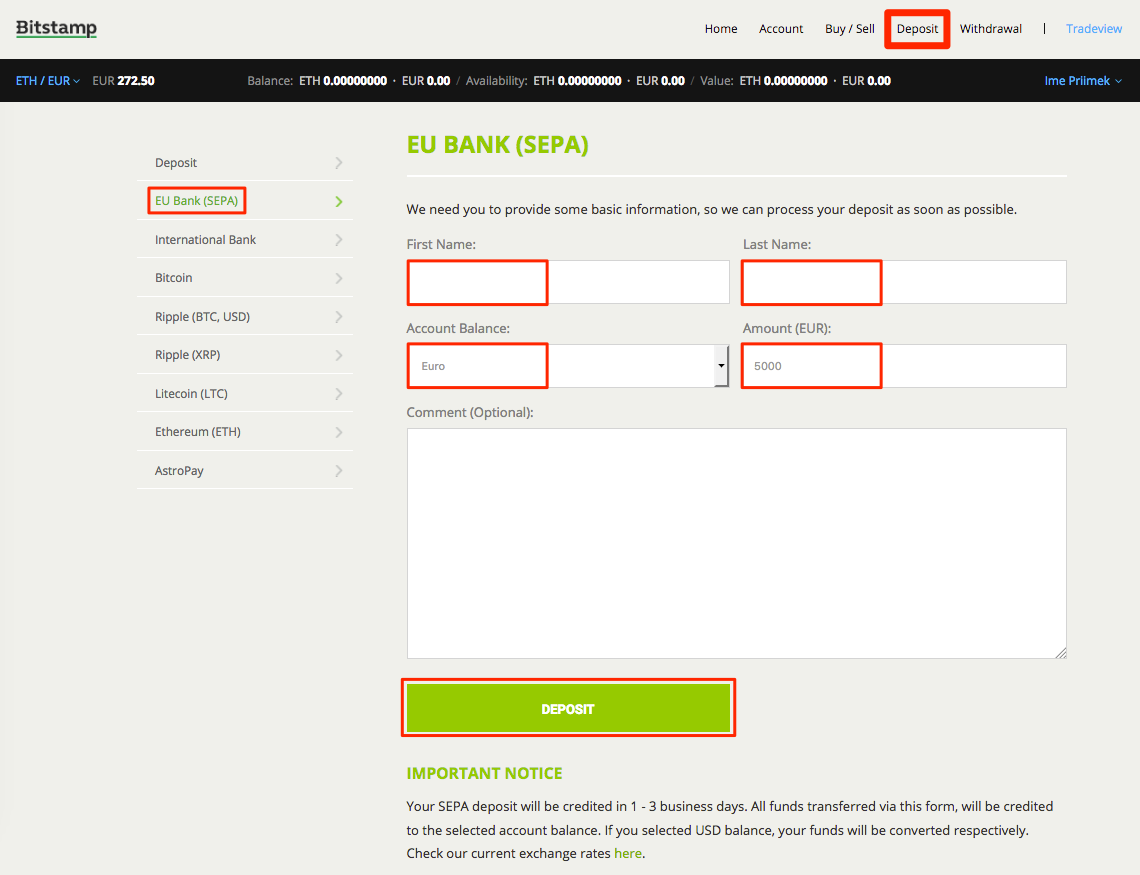
- Fill in all the required details.
Under Account Balance, chose Euro or USD (as the case may be). - Under Amount (EUR), enter the number of euros that you want to deposit on your Bitstamp account. (In our example, we’re depositing 5000 EUR.)
- Click the DEPOSIT button.
On the basis of your input in the previous form, Bitstamp will present you with the data you need for your SEPA money transfer.
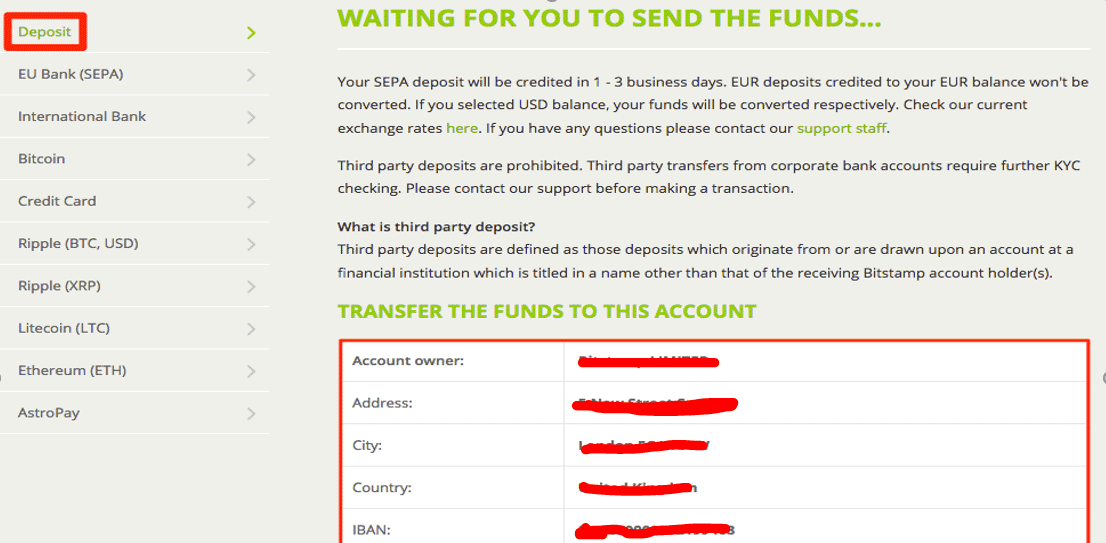
Note: You have to include the message number in your bank deposit message so that Bitstamp will know this is your account.
- Now fill in the SEPA form with your data and Bitstamp’s data. You can do this either at your bank or as an online payment.
Debtor (you):
You have to make sure to include the message number in debtor’s data (under a field such as a reference, debtor identifier, message, customer number, or similar).You need to input:
- Your name
- Your bank account number (IBAN)
- Residential address.
Creditor (Bitstamp):
Use the data provided in the previous step:
- Bitstamp’s name
- Address
- IBAN
When your deposit has been confirmed by Bitstamp. You are expected to receive an e-mail notification within 3-working days.
In your Bitstamp account, your deposit will look like this:

Trading On Bitstamp
Once your funds are confirmed, the simplest way to purchase Bitcoins is an instant order at the current bid/ask price. As the name suggests this usually results in your purchase going right away.
To place an instant order, click ‘Buy BTC’, then in the ‘I want to spend’ box enter the total amount of funds you want to use for buying Bitcoins. This amount includes Bitstamp's fees.
Click on ‘Buy BTC’ underneath to place your order. Once your order is processed, the amount will be added to your BTC balance. Visit https://www.bitstamp.net/account/balance at any time to check this.
Note:
Bitstamp imposes the following minimum trade amounts:
- Minimum allowable trades for EUR denominated trading pairs begin at 5 EUR
- Minimum allowable trades for BTC denominated trading pairs begin at 0.001 BTC
- Other trading pairs are denominated in the current fiat currency of the specific trading pair and are set at 5 units of the fiat currency.
- Click Buy/Sell in the upper menu, then Instant Order (Simple) in the left menu. There are four options on the left panel. Choose Instant Order
- Then click Buy ETH:
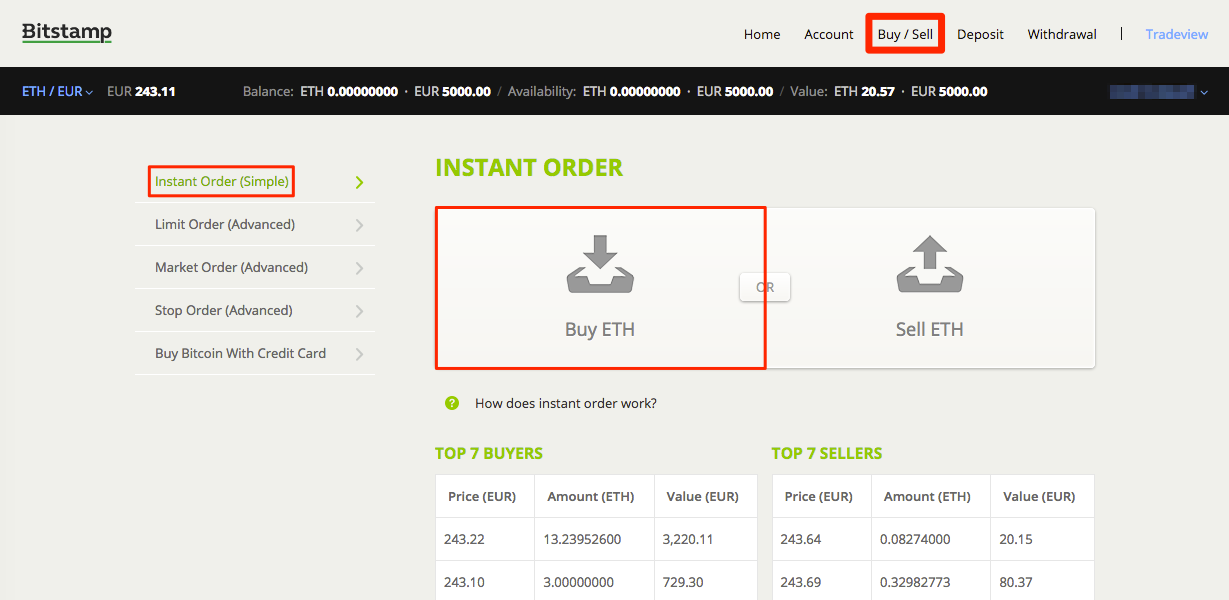
Under I Want to Spend, enter the amount in EUR that you want to exchange in ETH. In the upper row, you can see how much EUR you have available. Then click BUY ETH below.
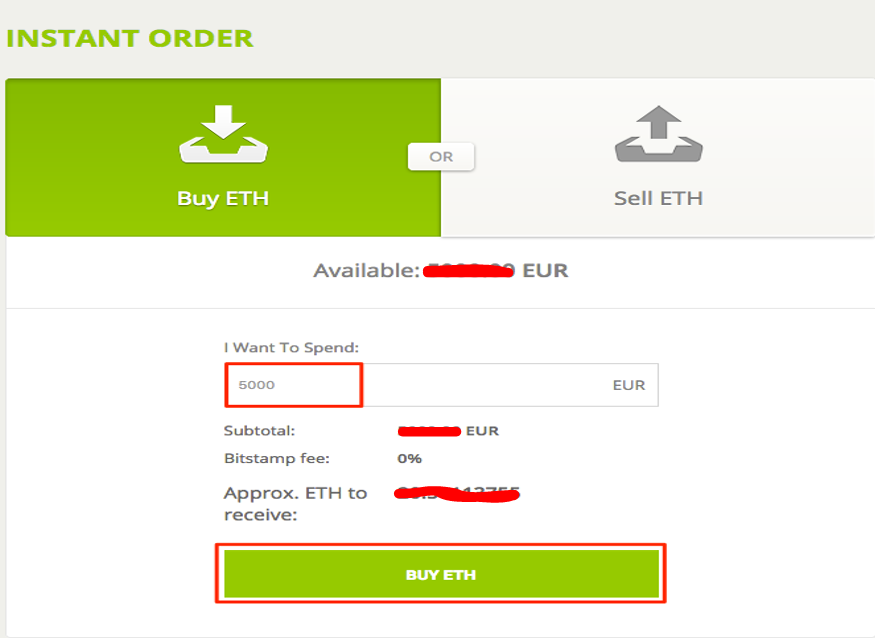
Note: Bitstamp fee for this transaction is 0%.
Approx. ETH to receive shows approximately how much ETH you can expect according to the current exchange rate.
Now your order to buy ETH is open and will soon be executed:

After the exchange has been successfully made, you will see a new Balance of ETH on your account:
![]()
Making withdrawal
All cryptocurrency withdrawals are free. Debit card withdrawals incur a fee of $10 of amounts up to $1000 USD. Withdrawals with credit cards above $1000 USD incur a 2% fee. International wire withdrawals incur a fee of 0.09%, with a minimum fee of $15 USD. Also, SEPA withdrawals incur a flat 0.90 EUR fee
To withdraw from your Bitstamp account, click “View My Account” under the drop-down tab as shown below:
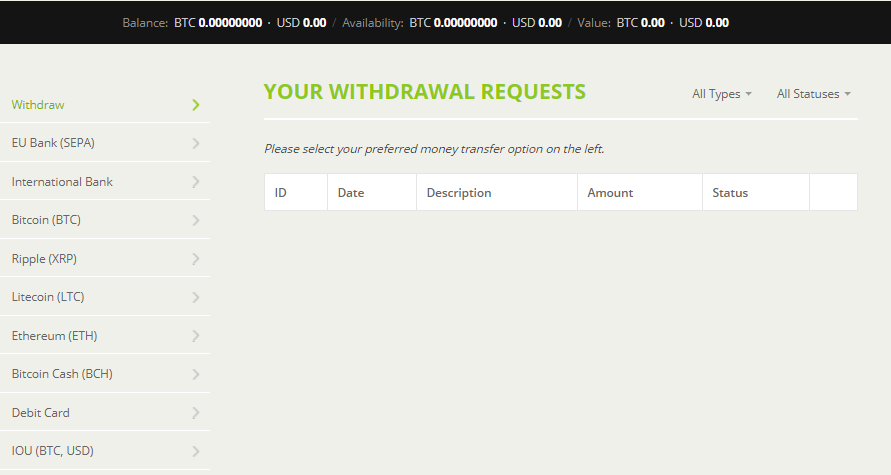
Click the “Withdrawal” link on the top left menu. Depending on the currency to be withdrawn, choose any of the options on the left panel and Follow the steps provided.
Cryptocurrency Information
Bitcoin Volumes Finally Grow Again and Bitfinex/Tether Issues Spark Systemic Risks, New Diar Report Affirms
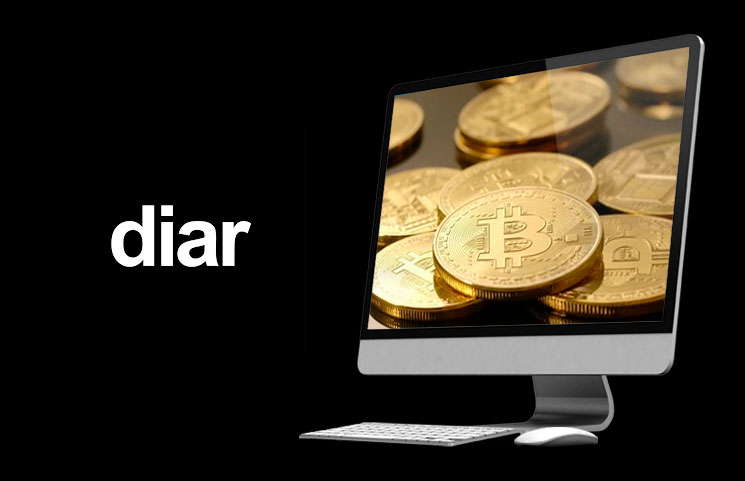
Diar has recently published its report of the crypto market for April. According to the company, Bitcoin volumes are finally growing again and the whole situation with Tether and Bitfinex showed the industry some of its systemic risks. DAI fee hikes and stablecoin projects were also highlighted in the report.
Bitcoin Goes Back To Growing Again
The main highlight of the month is, obviously, that Bitcoin is back on the action. After facing lows which started in 2018, the token has finally been able to effectively reverse the trends and have an actual price surge this month, going from less than $4,200 USD to over $5,200 USD during this short timeframe.
With this, the number of on-chain transactions has spiked for three months in a row, since prices started to get some of their value back in March and April. Now, transaction volumes are around their levels in June 2018 when the price of the asset was around $7,000 USD.
However, charts indicate that Bitcoin is yet to find more footing outside of speculative trading, so the bull market may not be as near as some think.
When looking at the volume of the whole quarters, Q1 2019 had lower volumes than Q4 2018, but Q2 2019 started considerably well.
Bitfinex and Tether Start Concerns of Systemic Risks
As you may have heard, Bitfinex was accused of using Tether funds to cover up its losses. According to Diar, there is a 26% shortfall of in-cash reserves to back Tether tokens (USDT). Tether loaned $850 million USD to Bitfinex to cover up losses and its general counsel Stuart Hoegner has affirmed that the company is operating with fewer reserves than the total market cap of the token.
This happened because Bitfinex had the $850 million USD “seized” by Crypto Capital, one of its payment processors. Unless Hoegner is lying, though, the company had the assets to back the stablecoin until recently.
While it is clear now that Tether simply does not have the money to back the funds, people simply keep buying the tokens. Now, instead of all cash, some shares of Bitfinex are being used to represent the rest of the value, which makes the stablecoin enter securities territory for the first time.
Curiously, the markets are all very tolerant now since the prices are still stable but the systemic risks are clear, especially if other companies are to follow Tether’s path.
DAI Hikes Fees Once More
Another situation highlighted by the reports is that DAI has decided to upgrade its stability fees once again as the community is desperately trying to make the prices of the so-called stablecoin go up again. DAI tokens are being sold for less than $1 USD, their official price, on secondary markets.
At the moment, the fees are 16.5%, after increasing three times in only one month. Before April, the fees were only 7.5%. This has resulted in a decrease of 4.9% in the circulation of DAI tokens.
Stablecoins Eye Wider Use Cases
Gemini and Harbor, a A16Z tokenized securities platform, have started a partnership in order to get more clients for the Harbor stablecoin. However, this was deemed “too soon” by Diar, as Harbor does not have any known token right now. The only one the company had was canceled.
TrustToken is also trying to get more stablecoins on its list, especially the ones that are not focused on USD, but on several other fiat currencies like HKD, CAD or GBP instead.
Cryptocurrency Information
#DropGold Campaign to Hit Your TV, Here’s A Breakdown of the Underlying Bitcoin Message(s)

Grayscale, a leader in digital currency investing, launched an ad on Wednesday, May 1, telling investors that money should be contributed to Bitcoin holdings as opposed to gold. In a number of interviews, CEO of Grayscale’s parent company (Digital Currency Group), Barry Silbert and Managing Director of Grayscale, Michael Sonnenshein, have since expressed the underlying message of the ad.
The #DropGold Ad
According to news outlet, U Today, the ad starts off with a man holding gold bars in his arm, which he decides to drop. While doing so, a woman also does the same. Throughout the ad, people supposedly have their gold bars stacked in shopping carts, while “losing their gold coins.” Watching what’s about to unfold, the two individuals try to find their way out.
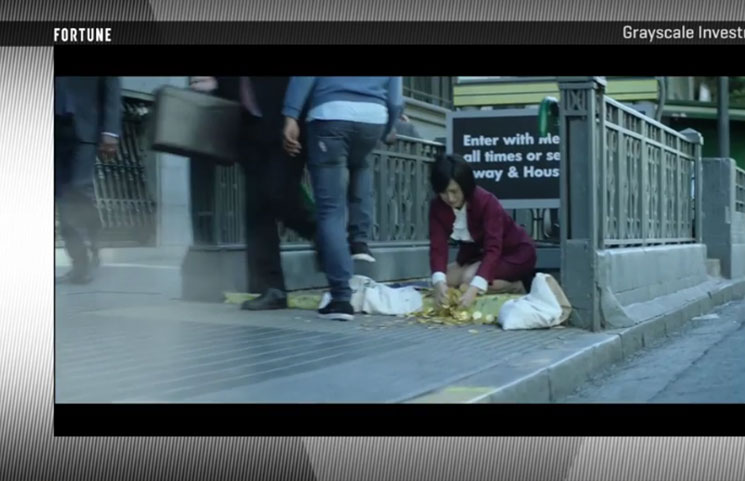
Advertising Bitcoin or Grayscale’s Services?
Despite being the one to have introduced this campaign, Silbert argues that it isn’t entirely about Grayscale services, but rather said services being a result of consumers’ decision. Yahoo Finance has since quoted the following comment made by Silbert himself:
“We do not see this as a Grayscale commercial. For us #DropGold is our ‘Got Milk’. This campaign is first and foremost focused on starting a conversation about bitcoin vs gold. If the ad makes people want to get into Bitcoin, we’re completely indifferent about how they go about doing it.”
Having said this, the commercial is evidently portraying Grayscale as an option, as towards the end, one is told, “Go Digital. Go Grayscale.”
Silbert’s and Sonnenshein’s Arguments Regarding Gold’s Limitations
Silbert believes that this campaign works towards addressing the fact that Bitcoin can serve as an equal asset class as gold, if not better. In particular, he was quoted saying, “But now you have Bitcoin, which, in our opinion, provides all the same attributes as gold – it’s fungible and scarce and you can’t counterfeit it – but the big difference is that Bitcoin has utility. Gold doesn’t have much utility beyond jewelry.”
He further argued that the goal here isn’t to replace fiat currency for shopping purposes, but rather to show the world that Bitcoin does a better job at doing gold’s job and this will be evident in the long run. Although he has acknowledged Bitcoin’s volatility as being concerning, he is hopeful that it will one day serve as both an ideal utility token and store of value.
As for Sonnenshein’s viewpoint, he sees this ad as revealing the “absurdity” associated with gold. More specifically, he said:
“We’re going after a narrative around gold being where investors should go when markets turn south or as a hedge against inflation […] we’re highlighting the absurdity of gold.”
As per The Block Crypto, Grayscale also tries to convince investors that the return earned from redistributing 5% of gold to Bitcoin will be greater than 5% yearly.
What are your overall thoughts on this ad? Did it leave you asking yourself, “Why did you invest in gold? Are you living in the past?” Share your thoughts below!
Cryptocurrency Information
Huobi Pro Bitcoin Exchange: Cryptocurrency Asset Trading Platform?
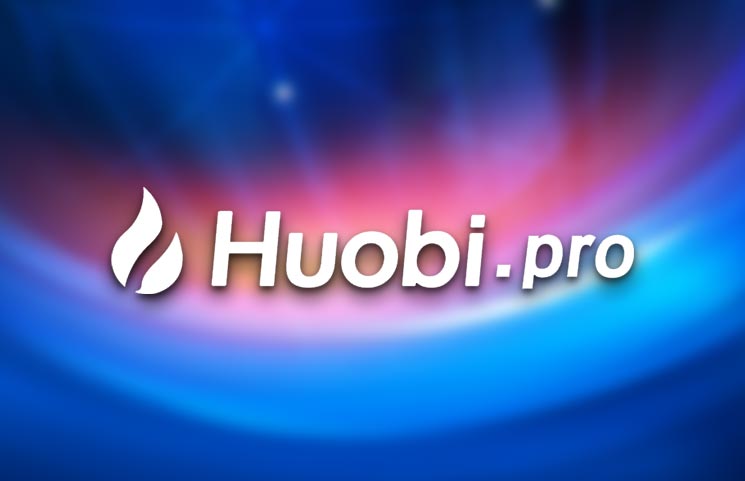
Huobi Pro Cryptocurrency Exchange
Founded in 2013, Huobi Pro allows for a myriad digital currencies to be exchanged, at a 0.2 percent trading commission. Loyal users point to the low fees and stellar service that make the exchange stand out above others.
Although pitched at dedicated cryptocurrency enthusiasts since the site doesn’t accept fiat currencies many who enter the realm on the back of fiat end up at Huobi Pro, largely due to its diverse offering and favorable fee structure.
Huobi Pro in A Nutshell

A victim of China’s clampdown on digital currencies, the company might be registered in the Seychelles, but was originally founded in Beijing. As testament to the broad appeal of the platform, after the Chinese regime effectively banned all things crypto at the beginning of 2018, trading volumes have only grown.
While at first very much a Chinese company looking at the home market, Huobi Pro has been forced to find a wider marketplace on the international scene. Indeed, even prior to the official cessation of altcoins and their trading, the company heard the rumblings in 2017 and took its cryptocurrency interests abroad.
Huobi now provides exchange services to users in over 130 countries. Company offices are located in the USA, Korea, Japan, Singapore and Hong Kong. Although the Huobi Group also owns and manages the Huobi Autonomous Digital Asset Exchange (HADAX), Huobi Pro is more of a pure “login and trade” exchange.
Users can employ network tokens to cast votes on adding new altcoins on HADAX. On the Huobi Pro exchange, a simplified offer encompassing all of the mainstream altcoins greets visitors. Some more popular coins offered are Bitcoin (BTC), Bitcoin Cash (BCH), Ethereum (ETH), Litecoin (LTC), NEM (XEM), NEO (NEO), Qtum (QTUM) and Ripple (XRP).
That said, when one actually tallies the number of altcoins available for exchange, it becomes apparent why loyal followers value the site. A marriage of both simple ease of use and diversity in trading, the platform is largely welcomed by newcomers and experienced enthusiasts alike. In the current melee of regulation being contemplated, implemented and tweaked all the while, some users may be precluded from trading on the exchange based on their country of residence.
Huobi Pro accepts the funding of accounts only in digital currencies, and accepts deposits in any of its listed altcoins. Unlike other exchanges that have opted for a midway between crypto and fiat, Huobi Pro traders deal strictly in digital coins at every point of a transaction. Funds need to be withdrawn to a wallet, and fiat users looking to buy in will have to establish a wallet first in order to fund their Huobi Pro trading account.
Traders pay a maker or taker fee of just 0.02 percent using the exchange. There are more detailed offers, worth looking at for daily traders with volume.
Huobi Pro Membership Levels
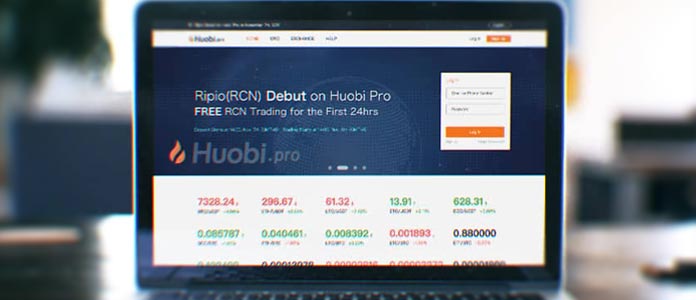
VIP users get preferential platform trading fees if they buy the privilege with Huobi tokens. The Huobi Token (HT) was never an ICO token, but rather a system token that users only obtain by buying “Point Cards” on the Huobi Pro platform. Point Card is essentially a pre-paid Huobi card that keeps users liquid on service fees. One HT = 1 USD, therefore one “point” = 1 USD. The more points purchased, the more free points are added, although savings on 1000 points, for example, means only 10 HT for free.
Huobi Global minted a fixed total of 500 million tokens, with 300 million employed to facilitate the in-house VIP structure. A mark of the business group behind the platform is seen in their practice of buying back-sold tokens from the open market each quarter. Not only that, but those funds go towards the Huobi Investor Protection Fund (HIPF).
This is a planned fund that will compensate investors who suffer platform disruption and subsequent losses. It’s a tool that minimizes risk, smooths out the market overall and also goes towards protecting investor interests. This transparent and pleasing aspect of the platform is one reason traders have confidence in the exchange, and its popularity is rising worldwide.
By way of example, in order to glean a VIP status, a trader will pay 120 HT a month for First Level membership. This enables a 20 percent discount on trading fees. Running through toward the top end, a pricier option of 6,000 HT a month secures a 50 percent discount on fees. Overall, a diligent trader can optimize the system and come out with a substantial discount on the already low 0.02 percent base offer.
The company charges no fees to deposit funds, but there are withdrawal fees. Although there are reviews online listing withdrawal fees, it appears that, especially within the membership structure, users are advised to ascertain exact fees when establishing their account. Likewise, transfer limits need to established upfront to avoid disappointment later. There exist order size limits on the platform too, again becoming more malleable as one moves up the ranks of the VIPs.
Security And UX On Huobi Pro

All of the standard protocols including two-step Google Authenticator verification are at play on the platform. Unlike many other exchanges that offer a simple crypto-exclusive platform, Huobi Pro will need your personal details in the form of a passport copy and chat room comments are not devoid of complaints, although almost all of them take issue with the structure of the platform and its potential pitfalls. There are few allegations of lost funds or other negligence on behalf of the company. On the whole, Huobi Pro seems to be rubbing off its decidedly corporate ethos onto the exchange – good news for traders overall.
Another serious boon for the cryptosphere as a whole is that over 98 percent of holdings are stored in an offline cold wallet or vault. Imbued with a strict customer service ethic, the platform probably sports the best customer service to date for crypto exchanges. Available 24/7 365, there is a live chat option onsite.
The platform intel is sufficient although newbies might have to scratch to paint a clear picture of how exactly everything works. The FAQs are thoughtful and, again, testament to a polished offering. Huobi used to be one of the biggest Chinese crypto exchanges, based in Beijing. Started by entrepreneur Leon Li in 2013, since the move there has been mutual appreciation of its value. Worldwide users have taken to the exchange, as it too realized that it had global appeal.
Huobi Pro Conclusion

Huobi claims to have exceeded BTC 500,000 in daily trading approaching 2014. Although only in its fifth year, that’s a long time in cryptocurrency. Although frequently accused of embellishing trading volumes, these allegations have never been proven. In comparison to other digital exchanges that have suffered persistent user complaints and even been shut down due to criminal activity, Huobi Pro shines.
As an offering, it has low fees, great diversity and an unbeatable crypto-energy. No trader on the platform feels like they’re missing out on something else somewhere else, by most accounts. Possibly due to their prior involvement in the fintech world, the platform got it right first time around and user numbers prove it. The company Huobi also owns another trading platform, BitYes, more focused on USD/BTC and USD/LTC pairs trading. Great customer service and minimal technical glitches have made it appear positively top-tier, again in comparison to less polished outfits.
With a detailed offering, great client liaison – very unusual for most digital exchanges so far – and no legitimate proof of anything even vaguely dark hanging about them, the Huobi Pro project is recommended. Users are advised to always ascertain costs prior to trading – not hard with the customer support in this case – and sample a platform with small trades before trading greater amounts. To learn more, you can head to their official website: huobi.pro










